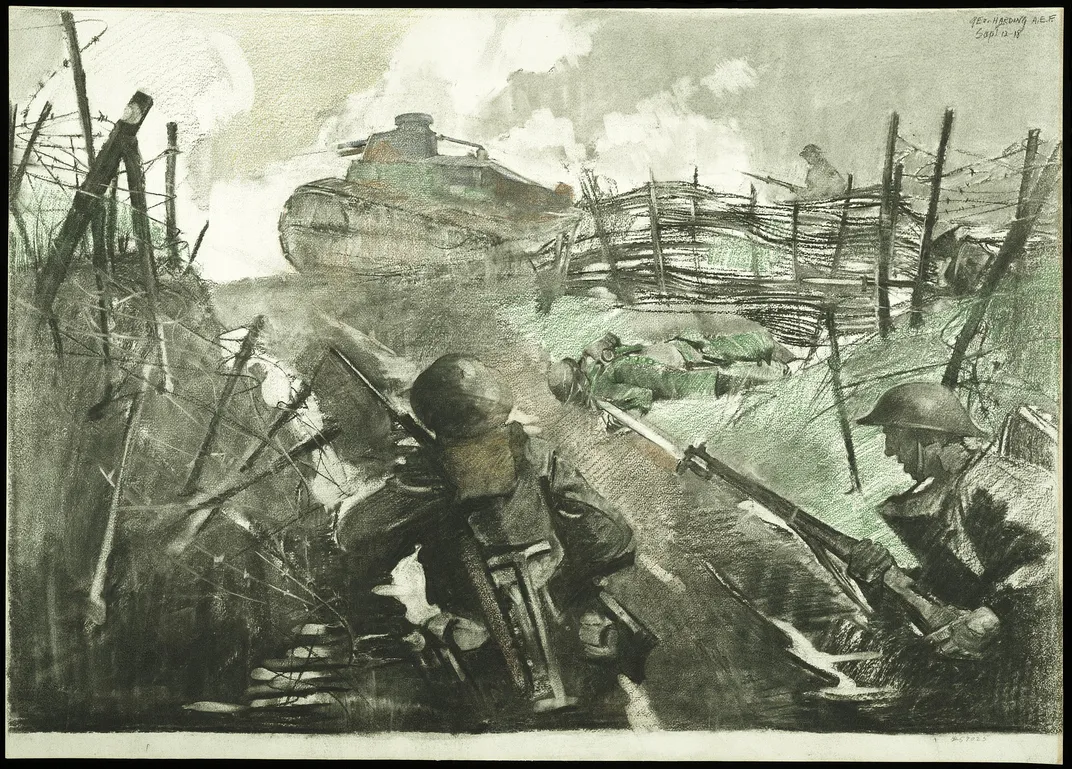This Riveting Art From the Front Lines of World War I Has Gone Largely Unseen for Decades
During WWI, the War Department sent American artists to Europe. The Smithsonian recently digitized the captivating artwork
In the words of one historian, “Art and war are old companions.” The United States government proved that nearly a century ago when it commissioned eight artists to go to war. Armed with sketchpads, charcoals, pastels and little to no military training, the artists embedded with the American Expeditionary Forces and sketched everything from rolling tanks to portraits of German prisoners. The War Department coordinated the program in the hopes that the artists could provide a historical record and galvanize support for the war.
Military leaders felt that art could capture the true essence of war. So they called upon eight men from the industry and sent them to France: six book and magazine illustrators—William James Aylward (1875-1956), Walter Jack Duncan (1881-1941), Harvey Thomas Dunn (1884-1952), George Matthews Harding (1882-1959), Wallace Morgan (1875-1948), Harry Everett Townsend (1879-1941), one an architect and etcher J. André Smith (1880-1959), and one “pure artist” Ernest Clifford Peixotto (1869-1940). The military made them captains in the Army Corps of Engineers and gave them free range. “They could go anywhere they wanted to go,” says historian Alfred Cornebise, author of Art from the Trenches: America’s Uniformed Artists in World War I.
Throughout 1918, prior to the war’s end in November, the artists produced some 700 works, ranging from charcoal sketches to completed ink or watercolor compositions. Bart Hacker, a curator at the National Museum of American History, says the artists depicted four types of scenes: soldier life (washing up, meal time); combat, aftermaths of war (destroyed churches, devastated fields); and technology. In one image, wounded men carry the fallen through trenches and barbed wire. In another, soldiers on horseback travel through a destroyed French village. Notably, Hacker says, the artists did not depict dead bodies.
While WWI marked the first time that the U.S. government commissioned artists to capture a war effort, though the program did not start until late in the war, the concept was well established abroad. “Every belligerent [nation] during the war established art programs,” Hacker says. “They were all recognizing that this was a world historical event and that picturing it for posterity was something really important.”
Still, the official American paintings and drawings differed from the European ones, not all of which were government commissions. Whereas European artists were portraying “expressionist and emotional reactions to the war,” says Elizabeth Prelinger, an art history professor at Georgetown University, the American artists “were over there in a much more documentary way.”
Prelinger notes the similar style in the American works, despite having come from the hands of eight different artists, and likens them to illustrations in American advertising from that period.
The artists sent finished works to their headquarters at Chaumont, France, and from there the paintings went to the War Department in Washington, D.C. The government exhibited some of the works right away, while it held others back, giving the artists time to complete them at a later date.
For many of the artworks, that date never came. On January 28, 1920, the War Department delivered the bulk of the collection to the Smithsonian, which exhibited them shortly after, before putting them in storage around 1929. Other than during a brief exhibition in the 1950s and temporary lending, the works have remained tucked away ever since.
This summer marks the centennial of the start of WWI and there remains an air of mystery around the art program and resulting collection. “It deserves more attention,” Cornebise says. “This would be a fantastic time for people to understand that this art is still there.”
Perhaps that time is not far away. The American History Museum has digitized the collection and may include some of the works in an upcoming exhibition, scheduled for 2017. Also, a paperback version of Cornebise’s book on the artists comes out next month.
The New Britain Museum of American Art has a collection of paintings and drawings that one of the artists, Harry Everett Townsend, made during the program. The South Dakota Art Museum has works by Harvey Dunn, also one of the artists, and will be featuring them in a new exhibition opening this Saturday, August 16, titled "Harvey Dunn: The Complete Collection."
Update 8/13/14: This post has been updated to include more information about the South Dakota Art Museum's upcoming exhibition.
/https://tf-cmsv2-smithsonianmag-media.s3.amazonaws.com/accounts/headshot/MAx2.jpg)

/https://tf-cmsv2-smithsonianmag-media.s3.amazonaws.com/filer/39/49/3949f2f1-41b0-445d-a428-8ddbd6c91044/2011-04006.jpg)
/https://tf-cmsv2-smithsonianmag-media.s3.amazonaws.com/filer/93/21/9321096c-561f-475b-ab26-3ccac3eaaae9/2011-04020.jpg)
/https://tf-cmsv2-smithsonianmag-media.s3.amazonaws.com/filer/ea/2a/ea2acc48-cdd2-4fb3-b3c2-6ceaa57c2074/2011-04025.jpg)
/https://tf-cmsv2-smithsonianmag-media.s3.amazonaws.com/filer/1e/75/1e753582-27ee-4fc6-acc1-28d70513cb23/2011-04120.jpg)
/https://tf-cmsv2-smithsonianmag-media.s3.amazonaws.com/filer/52/e4/52e42221-3a28-4fa9-aedf-1883fb851cb9/2011-04122.jpg)
/https://tf-cmsv2-smithsonianmag-media.s3.amazonaws.com/filer/b3/e1/b3e1b84d-5232-4746-9f9c-49a906eefa17/2011-04128.jpg)
/https://tf-cmsv2-smithsonianmag-media.s3.amazonaws.com/filer/79/20/79203845-afc5-4e2c-9cd1-d0ed99d8c51f/2011-04151.jpg)
/https://tf-cmsv2-smithsonianmag-media.s3.amazonaws.com/filer/7c/cc/7ccc676f-3668-48ff-80be-c3b9c82215a9/2011-04126.jpg)
/https://tf-cmsv2-smithsonianmag-media.s3.amazonaws.com/filer/13/d3/13d3287b-e5dc-4391-8609-7b7ce471dbd6/2011-04196.jpg)
/https://tf-cmsv2-smithsonianmag-media.s3.amazonaws.com/accounts/headshot/MAx2.jpg)